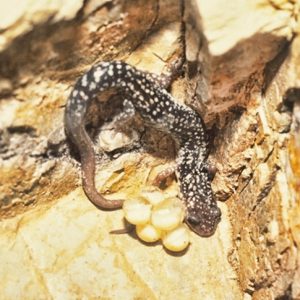calsfoundation@cals.org
Caddo Mountain Salamander
aka: Plethodon caddoensis
The Caddo Mountain salamander (Plethodon caddoensis) is a slender, medium-sized (90–100 millimeters in total length) terrestrial salamander. It is one of twenty or so members of the caudate family Plethodontidae that can be found in Arkansas. Adults of this species possess numerous tiny white spots and/or brassy flecks on the back and tail; the dorsal body color is otherwise uniformly black. The lateral body surfaces are creamy white in appearance. The throat region is distinctly pale or white. Juveniles may lack much of the lateral body coloration.
This species is one of three endemic salamanders known to exist in Arkansas and is primarily confined to the Caddo Mountains area of the southern Ouachita National Forest and several outlying areas in the south-central region of the state. Normally, these salamanders can be found within the crawlspaces of the loose gravelly surface rock conglomerates characteristic of hillsides within these mountains; however, they can also be found beneath exposed surface rocks and within rotting logs on the forest floor.
This salamander often occupies abandoned mines, with the highest concentrations of individuals—which may exceed 100 animals per mine—occurring during the months of July and August. Following the spring mating season, females enter mines in June and usually depart by late October. Females will also nest within these mineshafts during the nesting season of late summer and early fall. Eggs are deposited individually to form grape-like clusters that are adhered to nooks and crannies within the rock strata by gluey secretions from the female. Annual clutch size varies (usually five to ten eggs) according to female body size and nutritional state. Females do not leave their egg clutches but will brood the eggs throughout the entire nesting season. Incubation of eggs requires around two months, and females exit the mine along with their hatchlings. Males are normally not found in the mines during the nesting season.
The Caddo Mountain salamander feeds primarily on an assortment of invertebrate species that occur within their microhabitat niche. In addition, this species is almost exclusively nocturnal in its behavior. Its nighttime tree-climbing behavior suggests that the species may also take advantage of food resources that exist outside its subterranean habitat.
Chemical signaling serves several vital functions in male plethodontid salamanders. For example, in the Caddo Mountain salamander, secretions released from several gland clusters (distributed under the chin as a disk-shaped pad, on the dorsum of the tail, and within the cloaca) drive behavioral responses in reproductive females as well as establish territorial limits among males of the same species. Gland size changes with seasons and usually corresponds with annual courtship activities.
Recent genetic analyses of the Caddo Mountain salamander have revealed the presence of four highly divergent lineages. Each lineage appears to have responded to unique physiographic features associated with river and/or creek drainages within these mountains. Moreover, other related plethodontid salamanders (Plethodon fourchensis and Plethodon ouachitae) in the nearby Ouachita Mountain highlands have undergone different genetic divergences.
For additional information:
Pope, C. H., and S. H. Pope. “A Study of the Salamander, Plethodon ouachitae and the Description of an Allied Form.” Bulletin of the Chicago Academy of Science 9 (1951): 129–152.
Saugey, D. A., G. A. Heidt, and D. R. Heath. “Summer Use of Abandoned Mines by the Caddo Mountain Salamander, Plethodon caddoensis (Plethodontidae), in Arkansas.” Southwestern Naturalist 30 (1985): 318–319.
Shepard, D. B., and F. T. Burbrink. “Local-Scale Environmental Variation Generates Highly Divergent Lineages Associated with Stream Drainages in a Terrestrial Salamander, Plethodon caddoensis.” Molecular Phylogenetics and Evolution 59 (2011): 399–411.
Trauth, Stanley E., Henry W. Robison, and Michael V. Plummer. The Amphibians and Reptiles of Arkansas. Fayetteville: University of Arkansas Press, 2004.
Trauth, Stanley E., and J. D. Wilhide. “Status of Three Plethodontid Salamanders (Genus Plethodon) from the Ouachita National Forest of Southwestern Arkansas.” Journal of the Arkansas Academy of Science 53 (1999): 125–137. Online at http://libinfo.uark.edu/aas/issues/1999v53/v53a21.pdf (accessed December 9, 2025).
Stanley E. Trauth
Arkansas State University











Comments
No comments on this entry yet.